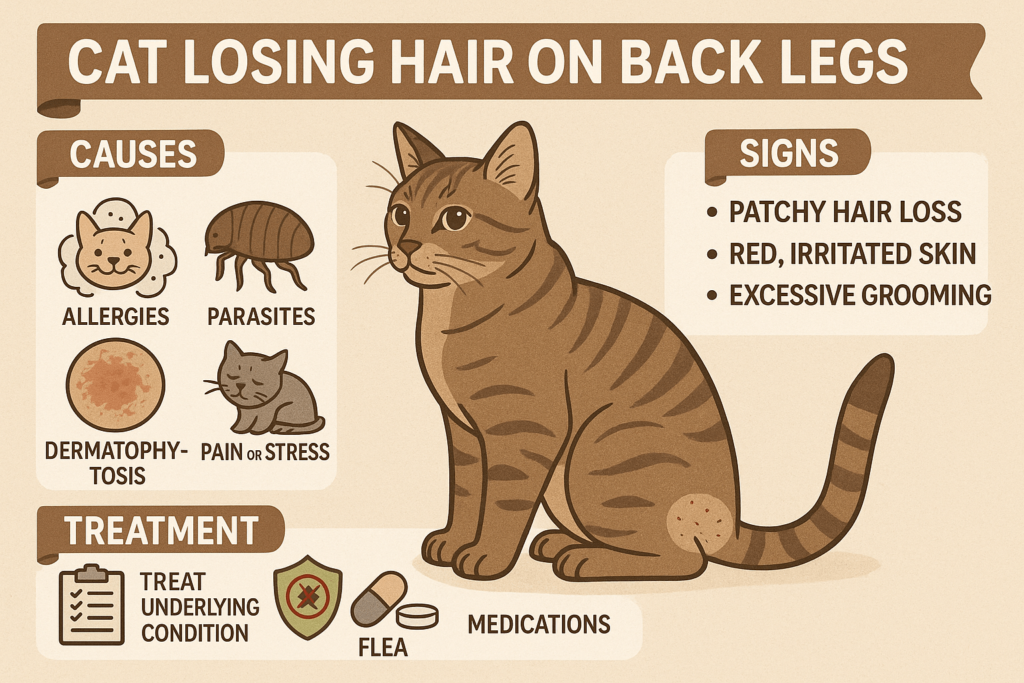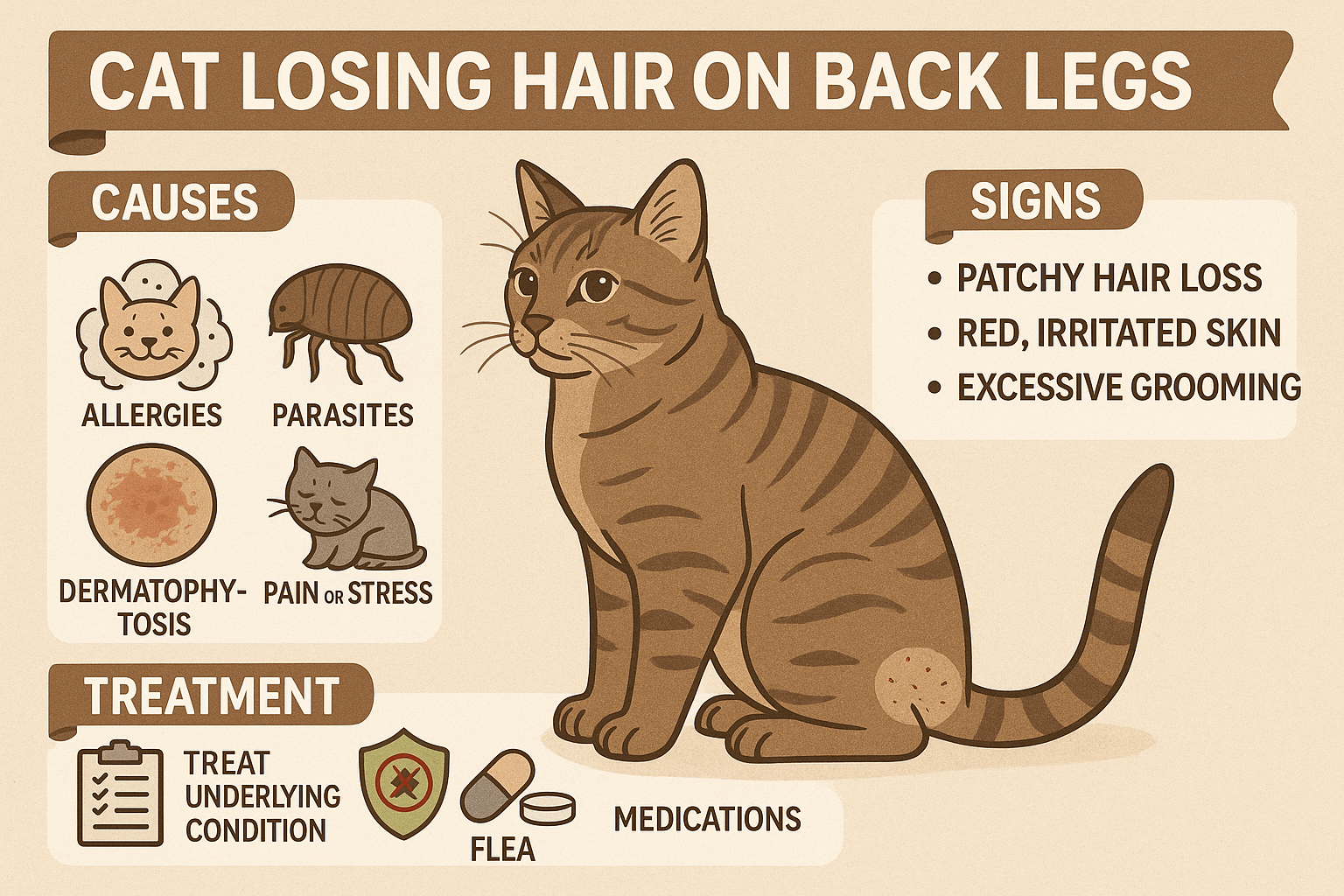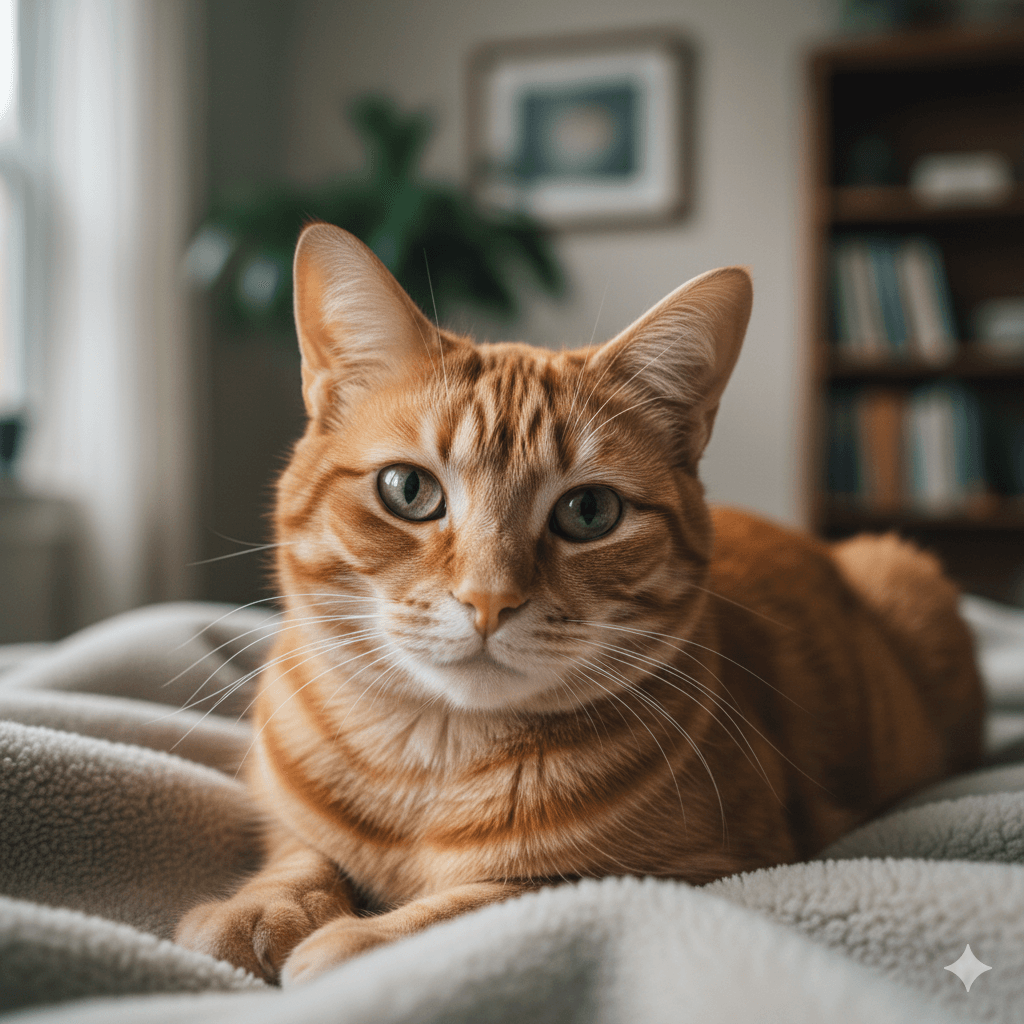Cat Losing Hair on Back Legs: What You Need to Know
If you’ve noticed your cat losing hair on their back legs, it’s natural to feel concerned. Hair loss in cats, also known as alopecia, can stem from a variety of causes ranging from minor issues to more serious health conditions. While some cases are harmless and resolve on their own, others may require veterinary attention to address underlying problems. Understanding the potential triggers, symptoms, and treatment options is key to ensuring your feline friend stays healthy and comfortable. In this guide, we’ll explore everything you need to know about why cats lose hair on their back legs and how to address it effectively.
Expert Insight: When to Consult Your Veterinarian
“Pet parents should let their veterinarian know if their cats are taking any new medications, showing any concerning symptoms, and how long the hair loss has been present.”
Common Causes of Hair Loss on Back Legs
Hair loss on a cat’s back legs can result from a wide range of factors. Identifying the root cause is essential for determining the appropriate course of action.
Allergies:
Cats can develop allergies to food, environmental factors (like pollen or dust mites), or flea bites, leading to itching and hair loss.Flea Infestations:
Fleas often target the lower back and hindquarters, causing intense scratching and subsequent hair loss.Stress or Anxiety:
Overgrooming due to stress or anxiety can lead to bald patches, particularly on the back legs and abdomen.Skin Infections:
Bacterial or fungal infections, such as ringworm, can cause localized hair loss and irritation.Hormonal Imbalances:
Conditions like hyperthyroidism or Cushing’s disease may disrupt hair growth cycles, resulting in patchy fur.
By pinpointing the specific cause, you can take targeted steps to alleviate your cat’s discomfort and promote healing.

Signs Your Cat May Be Experiencing Hair Loss Issues
Recognizing the early signs of hair loss on your cat’s back legs can help you address the problem before it worsens. Keep an eye out for these common symptoms.
Visible Bald Patches:
Look for areas where the fur is thinning or completely missing, especially around the thighs or lower legs.Excessive Licking or Grooming:
If your cat is obsessively licking or chewing their back legs, it could indicate irritation or discomfort.Redness or Scabs:
Inflamed skin or scabbing around the affected area may signal an infection or allergic reaction.Behavioral Changes:
Increased agitation, restlessness, or hiding could suggest your cat is experiencing pain or stress related to hair loss.Dull or Brittle Fur:
A decline in the overall quality of your cat’s coat may point to nutritional deficiencies or systemic health issues.
Being vigilant about these signs allows you to seek timely intervention and prevent further complications.
Check this guide 👉Cat Losing Hair on Belly: Best 7 Expert Tips!
Check this guide 👉Cat Losing Hair Around Eyes: Best 7 Expert Tips!
Check this guide 👉Cat Losing Hair at Base of Tail: Best 7 Expert Tips!
Possible Causes of Hair Loss | Recommended Actions |
|---|---|
Allergies | Identify and eliminate allergens; consult a vet for allergy testing. |
Flea Infestations | Use vet-approved flea treatments and clean your home thoroughly. |
Stress or Anxiety | Provide enrichment, maintain routines, and consult a behaviorist if needed. |
Skin Infections | Visit the vet for diagnosis and treatment with medication or topical solutions. |
Hormonal Imbalances | Schedule blood tests and follow up with hormonal therapy if prescribed. |
How to Prevent Hair Loss on Back Legs
Prevention is always better than cure when it comes to maintaining your cat’s coat health. Here are some proactive measures to minimize the risk of hair loss.
Regular Grooming:
Brush your cat’s fur regularly to remove loose hairs and prevent matting, which can irritate the skin.Flea Prevention:
Use veterinarian-recommended flea prevention products to keep your cat free from infestations.Balanced Diet:
Ensure your cat’s diet includes essential nutrients like omega-3 fatty acids, vitamins, and proteins to support skin and coat health.Minimize Stressors:
Create a calm environment by providing safe spaces, interactive toys, and consistent routines to reduce anxiety.Routine Vet Check-Ups:
Schedule regular veterinary visits to catch potential health issues early and keep your cat in optimal condition.
Taking these preventive steps can significantly reduce the likelihood of hair loss and keep your cat’s coat shiny and healthy.
Treatment Options for Hair Loss on Back Legs
Once the cause of your cat’s hair loss is identified, various treatment options can help restore their coat and comfort.
Medicated Shampoos:
Specialized shampoos can soothe irritated skin and treat conditions like fungal infections or dermatitis.Topical Treatments:
Creams or ointments prescribed by your vet can address localized inflammation or infections.Dietary Supplements:
Omega-3 supplements or specialized diets may improve skin health and promote regrowth of lost fur.Antibiotics or Antifungals:
If a bacterial or fungal infection is present, your vet may prescribe medications to clear the issue.Behavioral Therapy:
For stress-related hair loss, behavioral modification techniques or calming aids like pheromone diffusers can be effective.
With proper treatment tailored to the underlying cause, your cat’s coat can regain its natural beauty over time.
Common Myths About Cat Hair Loss
Misinformation about cat hair loss can lead to confusion and delayed treatment. Let’s debunk some common myths to set the record straight.
Myth: Hair loss is always caused by poor grooming.
Fact: Many medical and environmental factors contribute to hair loss beyond grooming habits.Myth: Only older cats experience hair loss.
Fact: Cats of all ages can suffer from hair loss due to various triggers.Myth: Hair will grow back on its own without intervention.
Fact: Without addressing the underlying cause, hair regrowth may not occur.Myth: Hair loss is purely cosmetic and not a health concern.
Fact: Hair loss often signals underlying health issues that require attention.Myth: Diet has no impact on hair loss.
Fact: Nutritional deficiencies can directly affect skin and coat health.
Dispelling these myths helps you focus on evidence-based solutions for your cat’s hair loss.
Environmental Factors Contributing to Hair Loss
Your cat’s surroundings play a significant role in their coat health. Addressing environmental factors can help prevent and manage hair loss effectively.
Temperature Extremes:
Extreme heat or cold can dry out your cat’s skin, leading to hair loss. Maintain a comfortable indoor climate.Household Cleaners:
Harsh chemicals in cleaning products can irritate sensitive skin. Opt for pet-safe alternatives.Litter Box Hygiene:
Poorly maintained litter boxes can expose your cat to bacteria or allergens that affect skin health.Exposure to Parasites:
Outdoor cats are more prone to fleas, ticks, and mites, which can cause hair loss. Limit outdoor access or use preventive measures.Overcrowded Living Spaces:
Stress from overcrowding or lack of personal space can lead to overgrooming and hair loss.
Optimizing your cat’s environment supports their overall well-being and minimizes hair loss risks.
The Role of Nutrition in Preventing Hair Loss
A balanced diet is crucial for maintaining your cat’s skin and coat health. Proper nutrition can prevent many causes of hair loss and promote regrowth.
High-Quality Protein:
Cats require animal-based proteins to support skin repair and hair growth.Essential Fatty Acids:
Omega-3 and omega-6 fatty acids nourish the skin and reduce inflammation.Vitamins and Minerals:
Nutrients like biotin, zinc, and vitamin E are vital for healthy skin and fur.Hydration:
Dehydration can lead to dry, flaky skin. Ensure your cat has access to fresh water at all times.Avoid Low-Quality Foods:
Low-cost, filler-heavy foods often lack the nutrients needed for optimal coat health.
Prioritizing nutrition not only prevents hair loss but also enhances your cat’s overall vitality and appearance.
Frequently Asked Questions About Hair Loss on Back Legs in Cats
Is hair loss on back legs normal for cats?
Some shedding is normal, but excessive or patchy hair loss is not and should be investigated.
Can fleas cause hair loss on my cat’s back legs?
Yes, fleas often target the hindquarters, leading to itching and subsequent hair loss.
How can I tell if my cat’s hair loss is due to stress?
Look for signs of overgrooming, behavioral changes, or other stress indicators like hiding or aggression.
Will my cat’s fur grow back after treatment?
In most cases, yes, as long as the underlying cause is addressed and the skin remains healthy.
When should I see a vet about my cat’s hair loss?
Consult a vet if the hair loss persists, worsens, or is accompanied by redness, scabs, or behavioral changes.
Restoring Your Cat’s Coat and Confidence
Hair loss on a cat’s back legs can be alarming, but understanding its causes and solutions empowers you to take meaningful action. Whether the issue stems from allergies, infections, or stress, addressing the root cause with patience and care ensures your cat regains their health and happiness. By staying attentive to your cat’s needs and seeking professional guidance when necessary, you can restore their coat’s luster and strengthen the bond you share. Remember, a little observation and effort go a long way in keeping your feline companion feeling their best.
How Fast Can a Cat Lose Weight: Best 7 Expert Tips! – Safe rates, warning signs & vet-approved strategies for healthy feline weight loss.
How Fast Can a Dog Lose Weight: Best 7 Expert Tips! – Safe rates, red flags, and vet-approved strategies for healthy dog weight loss.
Understanding Pilar Cyst in Cats: Best 7 Expert Tips! – Spot, assess & care for benign feline skin cysts with vet-backed guidance.
Understanding Pilar Cyst in Dogs: Best 7 Expert Tips! – Identify, monitor & manage benign skin cysts safely with vet-approved guidance.





